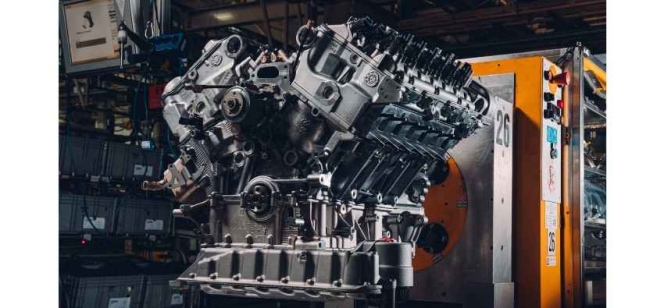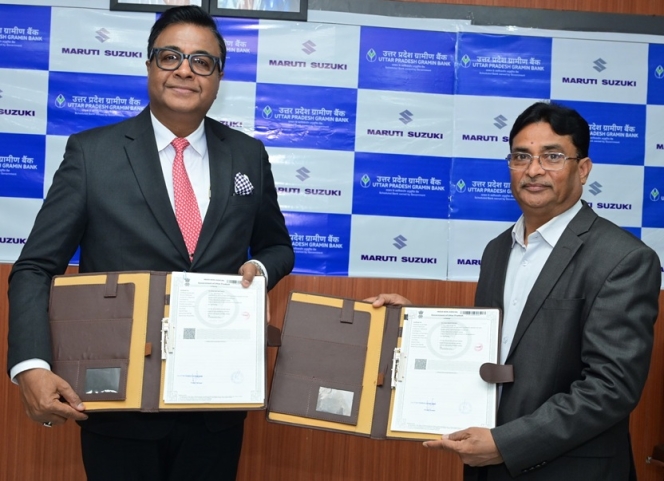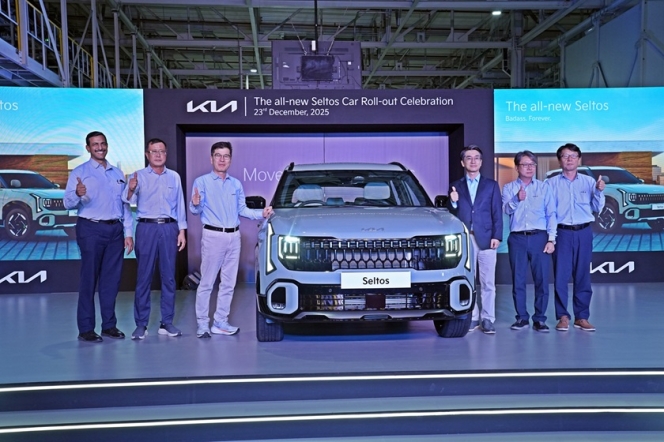Optimised Bacalar W12 Engine Delivers Improved Power, Torque
- By T Murrali
- April 11, 2021

The Bacalar spearheads a return to coachbuilding by Bentley Mulliner and features an enhanced version of Bentley’s peerless 6.0-litre W12 TSI engine, the most advanced 12-cylinder engine in the world.
Since the first introduction of the twin-turbocharger W12 in 2003, the engine’s refinement has seen an increase of up to 27 percent in power, 38 percent in torque and a reduction of 38 percent in emissions.
This has been realised through the evolution and optimisation of the crankcase, improvements in the oil and cooling systems, twin-scroll turbocharging technology and more effective injection and combustion processes.

Sources from Bentley told this correspondent that these improvements resulted from several initiatives taken by the company. It may be recalled that the latest generation of W12 was launched in the Bentayga in 2016. “A thoroughly reworked engine included a crankcase 30 percent stronger than its predecessor, while the cylinder surfaces were coated to reduce friction and improve corrosion resistance. A low-alloy steel coating is applied to the bores using an Atmospheric Plasma Spray (APS) process. Improvements were also made to the cooling system, with the engine featuring three separate coolant circuits. The first is designed to bring the cylinder heads up to optimum operating temperature as quickly as possible for best engine performance and low emissions. The second cool the engine block and oil system, while the third handles the turbochargers’ thermal load. Each system has a dedicated water pump, allowing optimised individual control,” sources said.
Twin-scroll Turbocharging
Twin-scroll turbochargers minimise turbo response time and provide a more efficient exhaust package. The exhaust assemblies for the three front and three rear cylinders are separate from one another, which feed the twin-scroll impellers. The turbocharger housing is welded directly to the exhaust manifolds and feature integrated speed sensors, allowing the engine to monitor turbo performance for maximum efficiency.
Effective Injection
The W12 combines high-pressure direct fuel injection (200 bar injection pressure) with low-pressure port injection (six bar). The combination of these two systems maximises refinement, lowers particulate emissions and optimises power and torque delivery.
Interestingly, each W12 engine is hand-built over 6.5 hours by a team of 45 craftspeople before undertaking a highly sophisticated test regime of over an hour via three specialist diagnostic machines during the engines assemble.
According to the sources, there were three specialist diagnostic machines with sophisticated test regime.
 Leak Test
Leak Test
The leakage test is conducted by pressurising each of the systems for fuel, oil and water individually. The different cavities are pressurised to values between 0.2 – 5.0 bar respectively and then measured whilst the pressure decays over time. The reduction in pressure versus time represents the quality of the sealing of the engine assembly. If the pressure drops faster than expected, a leak is indicated. A special fluid is sprayed on to the exterior of the engine to pin-point any leakage paths.
Cold Test
The engine is loaded on to a testbed plate, and connections are made to the engine loom and all engine systems, whilst a large electric motor couples to the engine via the crankshaft. “Motoring” the engine via the crankshaft allows the testbed to collect data from a suite of sensors. The facility measures 600 individual properties and characteristics of the engine during a 15-minute cycle. Due to the low running speed of 120 RPM for the test, finer details and any inconsistencies can be identified thanks to a sample rate that highlights even the briefest of anomalies that would be invisible if the engine was firing or running at speed. This fine detail analysis is also valuable for confirming the precise timing of the engine. Using positioning information from sensors on the crankshaft, crankcase and camshafts, and cylinder compression values, the Cold Test can confirm the engine timing is accurate and, therefore, achieve the best possible combustion cycle.
 Hot Test
Hot Test
When the engine arrives for hot testing, a UV dye is added to the engine to help identify any leaks. The coolant and fuel system are pressurised with air and nitrogen, respectively, for a final check before introducing the necessary fluids ready for testing. The engine is cranked to build oil pressure before the ignition system is energised and then left to idle whilst the engine test technician listens for any refinement issues and checks for leaks with a UV lamp. Sources said that each W12 is then tested for a minimum of 21.5 minutes and runs up to 3,800 rpm with a maximum load of 300 Nm. One in every one hundred engines receives a full eight-hour power test, achieving 6,000 RPM, and must achieve 900Nm.
The three tests that the Bacalar engine has already been put through are part of Bentley’s exceptional quality control processes. These testing procedures provide feedback on the quality of each engine and provide multiple checkpoints to catalogue the exact behaviour of each engine from the moment of manufacture. Since the installation of the three testbeds in 2002, over 100,000 W12 engines have been handcrafted in Crewe and passed through the test facility.
Technology Advancements
Bentley’s legendary 6.0-litre twin-turbocharged W12, created in 2002, has evolved into the latest iteration of the W12 engine used across today’s current model range. The unique W-configuration means that the engine is 24 percent shorter than an equivalent V12, benefitting packaging and maximising usable cabin space.
The latest generation of W12 was launched in the Bentayga in 2016. A thoroughly reworked engine included a crankcase 30 percent stronger than its predecessor, while the cylinder surfaces were coated to reduce friction and improve corrosion resistance. A low-alloy steel coating is applied to the bores using an Atmospheric Plasma Spray (APS) process.
 The W12 combines high-pressure direct fuel injection (200 bar injection pressure) with low-pressure port injection (six bar). The combination of these two systems maximises refinement, lowers particulate emissions and optimises power and torque delivery.
The W12 combines high-pressure direct fuel injection (200 bar injection pressure) with low-pressure port injection (six bar). The combination of these two systems maximises refinement, lowers particulate emissions and optimises power and torque delivery.
Twin-scroll turbochargers minimise turbo response time and provide a more efficient exhaust package. The exhaust assemblies for the three front and three rear cylinders are separate from one another, which then feed the twin-scroll impellers. The turbocharger housing is welded directly to the exhaust manifolds and feature integrated speed sensors, allowing the engine to monitor turbo performance for maximum efficiency.
Bentley’s variable displacement system shuts down half of the engine under defined conditions. Intake and exhaust valves, fuel injection and ignition are all shut down on defined cylinders, with the engine running as a six-cylinder for improved efficiency. The system will run in this mode in gears three to eight, below 3,000 rpm and up to 300 Nm torque output.
The first Bacalar engine followed the same build process in Bentley’s centre of excellence for W12 engines, ensuring the same level of quality and expertise before final testing, sources added. (MT)
Sustainable, Recyclable Electric Motors
Bentley Motors has announced a three-year research study that aims to revolutionise the sustainability of electric motors. Supporting Bentley’s commitment to offering only hybrid or electric vehicles by 2026, the result could see recycled rare-earth magnets used in selected ancillary motors for the very first time.
The study, titled RaRE (Rare-earth Recycling for E-machines), intends to build on work completed at the University of Birmingham in devising a method of extracting magnets from waste electronics. The project will also scale up this process and repurpose the extracted magnetic material into new recyclable magnets for use within bespoke ancillary motors.
Adding to the sustainability benefits that RaRE will provide, the bespoke motors created through this method promise to minimise complexity through manufacture while supporting the development of the UK supply chain for both mass production and low volume components.
Dr Matthias Rabe, Member of the Board for Engineering, Bentley Motors, said, “As we accelerate our journey to electrification, offering only hybrid or electric vehicles by 2026, and full electric by 2030, it is important that we focus on every aspect of vehicle sustainability, including sustainable methods of sourcing materials and components. RaRE promises a step-change in electrical recyclability, providing a source of truly bespoke, low voltage motors for a number of different applications, and we are confident the results will provide a basis for fully sustainable electric drives.”
This study will run in parallel to Bentley’s OCTOPUS research programme, which aims to deliver a breakthrough in e-axle electric powertrains, utilising a fully integrated, free from rare-earth magnet e-axle that supports electric vehicle architectures.
As with OCTOPUS, RaRE is an OZEV funded project delivered in partnership with Innovate UK, which brings together the following partners with distinct roles and responsibilities. Bentley Motors will lead specification setting and test protocol development and support the design and manufacturing activities, while Hypromag will scale up the recycling processes developed at the University of Birmingham and convert the extracted powders to sintered magnets with properties designed around those required for the auxiliary motors. On its part, Unipart Powertrain Applications Ltd will lead the development of manufacturing scale-up routes to ensure facilities and processes defined are suitable for volume automotive manufacture.
Advanced Electric Machines Research Ltd will lead the motors’ design and development, while Intelligent Lifecycle Solutions Ltd will pre-process computer hard disk drives to remove the rare earth magnet containing components from the waste, which will be shipped to Hypromag for removal of the rare earth magnets. The University of Birmingham will provide cast alloys, which will be fed into Hypromag to blend with secondary materials to produce sintered magnets. (MT)
Citroen India Delivers 51 C3 CNG Vehicles To Luthra Group
- By MT Bureau
- December 24, 2025
Citroen India, in partnership with its dealership La Maison Nanavati, has completed the handover of 51 Citroen C3 CNG vehicles to the Luthra Group. The ceremony took place at the Luthra Group’s headquarters in Surat.
The delivery is part of Citroen's strategy to expand its presence in tier-II and tier-III markets by providing mobility solutions to businesses and individuals.
The Citroen C3 CNG is designed for high-usage environments and daily commutes. The model includes several features tailored for the Indian market, integration of a factory-fitted CNG kit to manage running costs. A suspension system tuned specifically for local road conditions. Provisions for cabin space and air-conditioning systems designed for high-ambient temperatures.
The handover to Luthra Group represents the brand's focus on cost-efficient transportation. By targeting the regional business sector, Citroen India aims to strengthen its footprint in Gujarat and the broader Indian mobility market.
The C3 CNG is positioned as a solution for users requiring reliability and low operating expenses without compromising on ride comfort.
Maruti Suzuki India Partners Uttar Pradesh Gramin Bank For Retail Financing
- By MT Bureau
- December 24, 2025

Maruti Suzuki India has signed a Memorandum of Understanding (MoU) with Uttar Pradesh Gramin Bank, a regional rural bank, for vehicle retail financing partnership on new cars, pre-owned vehicles and commercial vehicles.
This collaboration marks the 50th retail finance partner for Maruti Suzuki India. The partnership is intended to use the bank’s network to provide credit options to a range of customer profiles, particularly in rural and semi-urban regions.
The partnership aims to increase the accessibility of Maruti Suzuki products through, tailored finance schemes designed for rural and regional customers.
Partho Banerjee, Senior Executive Officer, Marketing & Sales, Maruti Suzuki India, said, “Our partnership with Uttar Pradesh Gramin Bank marks a significant milestone as we onboard our 50th retail finance partner. This reinforces our commitment to making car ownership simpler and more affordable for customers across India. By expanding our reach through this strategic alliance, we aim to empower buyers with competitive, customer-friendly financing solutions that enhance the overall purchase experience. We remain focused on delivering seamless, tailored finance options, and this collaboration strengthens our vision of providing the Joy of Mobility to aspiring Indian consumers.”
Yadav S. Thakur, Chairman, Uttar Pradesh Gramin Bank, said, “At Uttar Pradesh Gramin Bank, empowering customer aspirations is at the heart of everything we do. Our partnership with Maruti Suzuki, a leader in the automotive industry, is a strategic step towards enhancing our service offerings and delivering greater value to our customers. This collaboration aligns with our 'Customer-First' mission, enabling us to provide accessible and affordable vehicle financing solutions. We look forward to helping more individuals and families across the country realise their dream of owning a Maruti Suzuki vehicle.”
Kia India Commences Production Of New Seltos In Anantapur
- By MT Bureau
- December 23, 2025

Kia India has started production of the latest generation Seltos at its manufacturing facility in Anantapur. The company has confirmed that prices for the mid-SUV will be announced on 2 January 2026.
The Anantapur plant, established in 2019, serves as a hub for both the Indian domestic market and international exports. The facility uses automation and a local workforce to manufacture the Seltos, which was the first model produced by the company in India.
The new model is built on Kia’s K3 platform, which has been engineered to increase structural rigidity and improve suspension damping. The vehicle has grown in size compared to its predecessor to increase cabin space and stability. It has 4,460 mm of length, 1,830 mm of width and a wheelbase of 2,690 mm.
The exterior design follows the ‘Opposites United’ philosophy, featuring a ‘Digital Tiger Face,’ LED projection headlamps, and alloy wheels with neon brake callipers.
The vehicle integrates several digital interfaces and driver assistance systems. It features an upgraded Kia Connect 2.0 suite with over-the-air (OTA) software updates and a proximity unlock function.
In terms of safety, it gets 24 features as standard, while ADAS Level 2 offers 21 autonomous features to assist the driver. The Kia Seltos SUV comes with three engine options – 1.5-litre Petrol producing 115 PS of power and 144 Nm of torque, 1.5 T-GDI Petrol producing 160 PS of power and 253 Nm of torque and a 1.5-litre diesel engine producing 116 PS of power and 250 Nm of torque.
Transmission choices include a 6-speed manual (6MT), intelligent manual (6iMT), IVT, 7-speed dual-clutch (7DCT) and a 6-speed automatic (6AT). The model will be sold in four trims – HTE, HTK, HTX and GTX – with additional option variants and an X-Line styling pack.
Gwanggu Lee, Managing Director & CEO, Kia India, said, “The roll-out of the All-New Kia Seltos marks a proud milestone for Kia India. Seltos has long set benchmarks in the mid-SUV segment, and this new generation represents a bigger, bolder, and more progressive evolution shaped by insights from Indian customers. With production now underway at our Anantapur facility, our teams are fully geared to ensure customers can take delivery of their all-new Seltos without long waiting periods. We are confident the all-new Seltos will once again redefine expectations in the segment and strengthen Kia’s leadership in India."
“The new Seltos looks fantastic. The Anantapur team, together with our supplier partners, have done an outstanding job in delivering our customers a great looking, significantly bigger, technologically progressive and safe vehicle with impressive functionality and connectivity,” he said.
- Citroen India
- Jeep
- Stellantis
- Citroen 2.0
- Shailesh Hazela
- Kumar Priyesh
- Sree Venkata Teja Kethineni
- VTK Automobiles
Citroen India Opens 126th Outlet In Chennai Under Citroen 2.0 Strategy
- By MT Bureau
- December 23, 2025

Stellantis-owned French automotive brand Citroen India has inaugurated its 126th point of sales and service (POS&S) facility in Chennai, continuing the expansion of its network under the ‘Citroen 2.0 – Shift Into The New’ strategy.
The new 3S (Sales, Service and Spares) facility is located at Chitlapakkam, near Chrompet. It is an extension of the partnership with VTK Automobiles, which now operates five Citroen touchpoints in the city. The outlet functions as a ‘Stellantis Brand House,’ allowing customers to access both Citroen and Jeep brands within a single space.
Since the announcement of the Citroen 2.0 strategy, the brand has increased its network by 48.6 percent. Over the last six months, the company added 43 points of sale through its network expansion programmes. Citroen expects to reach a total of 135 outlets by the end of the year, with further operations planned for the north, west, and east of India.
The strategy focuses on several pillars – deepening the domestic supply chain for India-centric products. Expanding the dealer footprint into Tier 2 and Tier 3 locations. Using digital tools and unified spaces for sales and aftersales services.
Shailesh Hazela, CEO and Managing Director, Stellantis India, said, “The expansion of Stellantis network further with VTK dealership in Chennai marks another important step in Citroen and Jeep India’s network growth strategy. Chennai is a key market for us, and this upgraded facility will enable us to serve our customers better with a seamless sales and ownership experience. Aligned with our Citroen 2.0 strategy, we remain committed to strengthening our dealer partnerships and building a robust, customer-centric network across the country.”
Kumar Priyesh, Director Automotive Brands, Stellantis India, said, “We have grown our network by almost 48.6 percent since we announced the Citroen 2.0 strategy and have been able to expand our operations in different parts of country: adding tier 2/3 locations while further strengthening in Metro/ Tier 1 cities. Through project Visitar, Network Expansion Program and expansion in new geographies we added over 43 POS in the last 6 months and are already in advanced stages to start additional operations in North, West and Eastern parts of the country and expected to close the year with 135 POS for Citroen.”
Sree Venkata Teja Kethineni, Dealer Principal, VTK Automobiles, said, “We’re happy to partner to this pivotal shift in automotive retail, proudly representing Jeep and Citroen. Our dual-brand strategy empowers us to deliver a truly elevated and distinctive experience – whether customers seek rugged performance or refined sophistication. With passion, professionalism and personalised care at the core, our team is committed to exceeding expectations and upholding the global standards these iconic brands represent.”
The facility includes a service centre equipped with diagnostics and digital tools. Staff members are trained across both Jeep and Citroen product lines to provide technical support and product information.






Comments (0)
ADD COMMENT